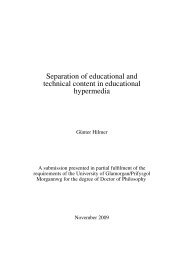framework for the implementation of a virtual design studio model in ...
framework for the implementation of a virtual design studio model in ...
framework for the implementation of a virtual design studio model in ...
Create successful ePaper yourself
Turn your PDF publications into a flip-book with our unique Google optimized e-Paper software.
Appendix D<br />
m. Case Studies <strong>for</strong> Phase 1 Stage 3<br />
i. Case <strong>of</strong> Sydney University:<br />
Sydney University has a history <strong>of</strong> experiment<strong>in</strong>g with <strong>the</strong> VDS s<strong>in</strong>ce <strong>the</strong> 1991 when <strong>the</strong><br />
famous book “understand<strong>in</strong>g <strong>virtual</strong> <strong>design</strong> <strong>studio</strong>” was published. In <strong>the</strong> collaboration<br />
side Sydney university has experimented and practiced an cross discipl<strong>in</strong>e VDS as well as<br />
cross universities VDS with some o<strong>the</strong>r worldwide universities. This enables <strong>the</strong> student<br />
to ga<strong>in</strong> experience with deal<strong>in</strong>g with different cultures (multicultural VDS).<br />
The use o media <strong>in</strong> Sydney University has <strong>in</strong>cluded <strong>the</strong> use <strong>of</strong> digital course materials as<br />
well as digital media <strong>for</strong> draw<strong>in</strong>g and sketch<strong>in</strong>g.<br />
The use <strong>of</strong> advanced 3D tools <strong>in</strong> Sydney’s VDS is obvious by <strong>the</strong> use <strong>of</strong> s<strong>of</strong>tware such as<br />
<strong>virtual</strong> world <strong>for</strong> communicat<strong>in</strong>g <strong>in</strong> both synchronous and asynchronous modes as well<br />
as us<strong>in</strong>g avatar technology <strong>for</strong> represent<strong>in</strong>g participant <strong>in</strong> <strong>the</strong> <strong>studio</strong>. The use <strong>of</strong> WebCT<br />
course management tools is also present <strong>for</strong> manag<strong>in</strong>g student progress and monitor<strong>in</strong>g<br />
<strong>the</strong>ir participation <strong>in</strong> <strong>the</strong> <strong>studio</strong> activities.<br />
Duration <strong>of</strong> VDS at Sydney varied accord<strong>in</strong>g to course requirement from as little as two<br />
weeks to as long as three or four semesters.<br />
Student at Sydney has been practic<strong>in</strong>g with VDS <strong>in</strong> different sets <strong>of</strong> <strong>design</strong> briefs<br />
accord<strong>in</strong>g to <strong>the</strong> course requirements. Some complex problems have been tackled as<br />
well as short term s<strong>in</strong>gle problems.<br />
At Sydney university <strong>the</strong> <strong>in</strong>terest was on <strong>the</strong> technology side as well as <strong>the</strong> educational<br />
side, <strong>in</strong> ano<strong>the</strong>r words <strong>the</strong> university competed to <strong>in</strong>tegrate <strong>the</strong> highest technology as<br />
far as VDS is concerned such as <strong>the</strong> use <strong>of</strong> avatars and 3D objects as well as <strong>the</strong> use <strong>of</strong><br />
course management systems to be able to manage <strong>the</strong> students progress and<br />
contribution to <strong>the</strong> course.<br />
ii. Case <strong>of</strong> Strathclyde University<br />
In Strathclyde University <strong>the</strong> experiment with VDS started as early as <strong>the</strong> 1996 when <strong>the</strong><br />
ICON project (Institutional Collaboration Over a Network) which was a jo<strong>in</strong>t project<br />
between <strong>the</strong> Department <strong>of</strong> Design, Manufacture and Eng<strong>in</strong>eer<strong>in</strong>g Management<br />
(DMEM) at <strong>the</strong> University <strong>of</strong> Strathclyde and <strong>the</strong> Department <strong>of</strong> Product Design<br />
Eng<strong>in</strong>eer<strong>in</strong>g at Glasgow School <strong>of</strong> Art (GSA). Third year undergraduate students work <strong>in</strong><br />
pairs, one from each <strong>in</strong>stitution, on an <strong>in</strong>tensive eight/n<strong>in</strong>e-day-long collaborative<br />
<strong>design</strong> task. All stages <strong>of</strong> <strong>the</strong> activity <strong>in</strong>volved <strong>in</strong> this task, from <strong>in</strong>itial generation <strong>of</strong> ideas<br />
through to f<strong>in</strong>al presentations, are coord<strong>in</strong>ated by means <strong>of</strong> remote <strong>in</strong>teraction between<br />
members <strong>of</strong> a pair, supported by a range <strong>of</strong> communication technologies. These <strong>in</strong>clude<br />
shared whiteboard and workspace, email and chat facilities, and audio and video l<strong>in</strong>ks.<br />
The ICON project was <strong>the</strong>n developed <strong>in</strong>to ICON 1 <strong>in</strong> June 1997 and ICON 2 <strong>in</strong><br />
September 1998. This project web sight was <strong>the</strong> precursor <strong>of</strong> <strong>the</strong> Clyde Virtual Design<br />
89



